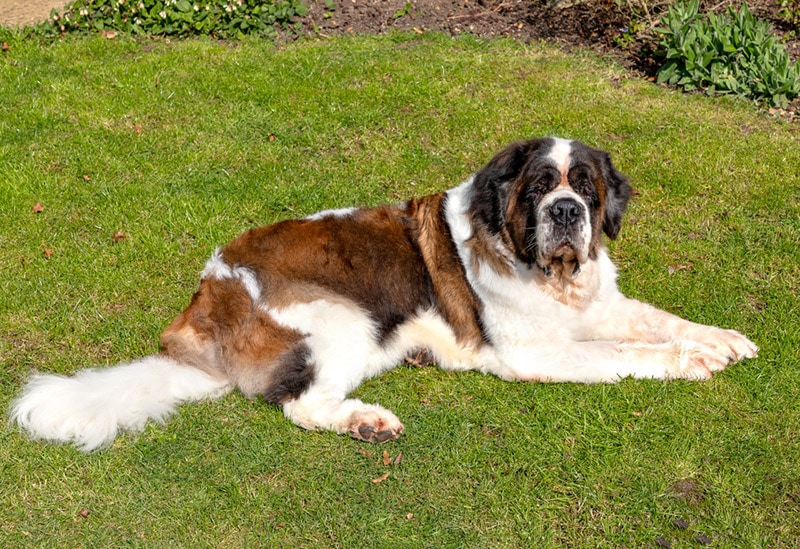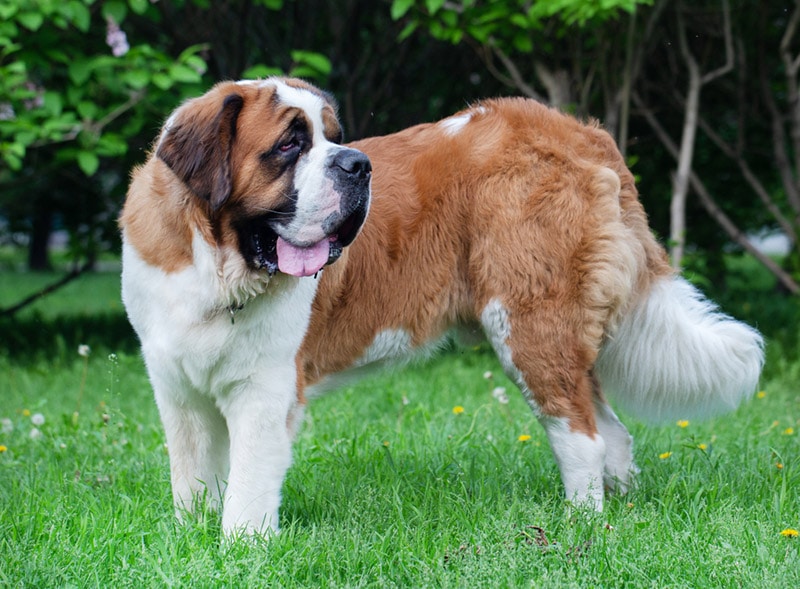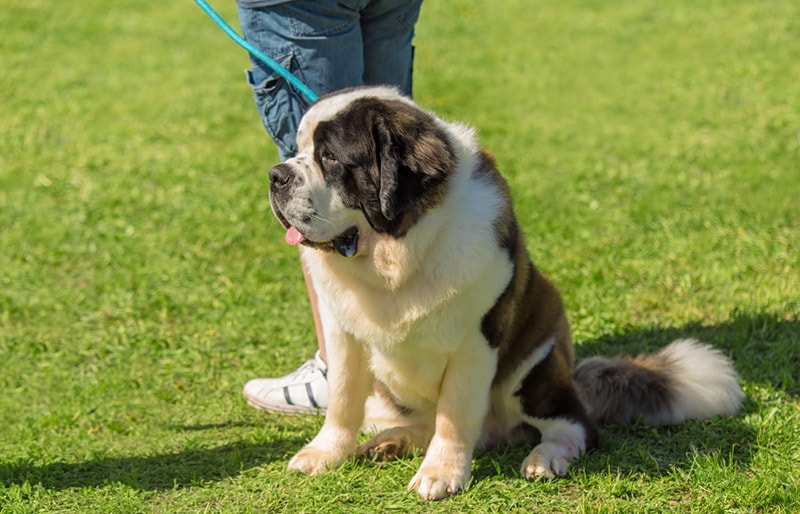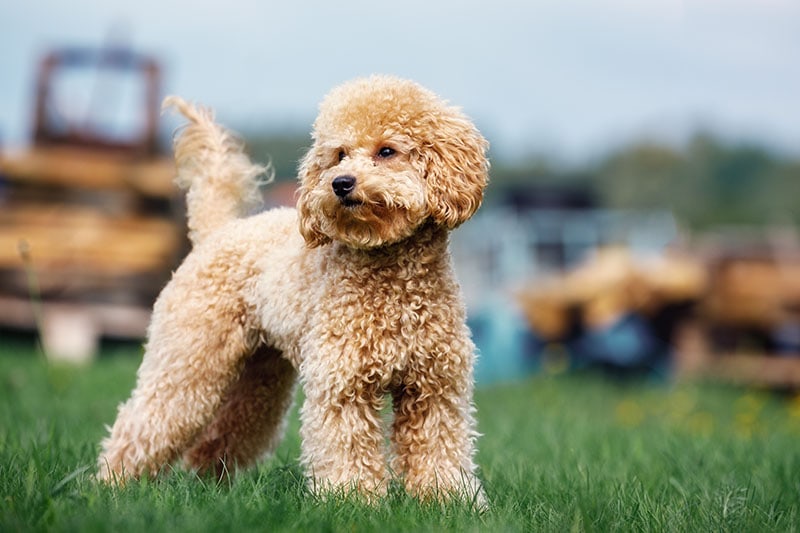How Big Do St. Bernards Get? Growth & Weight Chart

Updated on

Click to Skip Ahead
St. Bernards are large dogs with warm and gentle personalities. If you have a puppy of the breed, watching it get bigger and bigger each day can leave you with many questions. How big is an adult St Bernard? When does the dog stop growing?
Adults weigh between 120 and 200 pounds and can be as tall as 30 inches, depending on gender and genetics.
St. Bernards undergo a growth spurt between one and twelve months. If you think your puppy is growing too fast, it probably is. The growth pace only slows down after the first year and eventually stops once the dog is two years old.
If you are curious about how big St. Bernard dogs get, read on for a detailed growth and weight chart. We will also discuss the main aspects that can influence the size of your dog.
St. Bernard Breed Overview
St. Bernards are giant-sized dogs native to the monastery hospice in the Swiss Alps.
Although they were originally bred as watchdogs, they gained popularity because of their sharp instincts and ability to save people from life-threatening situations. These dogs are believed to have made nearly 2,000 alpine rescues over the centuries!1
St. Bernards are good-natured dogs initially bred to be watchdogs. While they are hardly aggressive and are warm even towards strangers, they are highly intuitive and can sense danger. They make good guard dogs because of their intimidating size and ability to do what it takes in case of a threat.
This breed is not highly energetic and only requires moderate exercise. A stroll around the yards or an hour of moderate-intensity exercises daily is enough to keep their weight in check. You must keep your sessions short and exciting and provide fresh water while at it. Also, do not engage in activities that can cause heavy panting because the breed is susceptible to heat exhaustion and heatstroke.
Training and socialization are essential for St. Bernard dogs. Although socializing them is not hard because of their friendly personalities, training can be challenging.
However, they have a strong sense of smell, and their noses can hinder successful training sessions. You must be consistent in your instructions and provide positive reinforcement for your pet to feel inclined to obey you.
Once you adopt your pet, it would help if you kept an eye on health conditions prone to the breed. They include hip dysplasia, elbow dysplasia, entropion, dilated cardiomyopathy, cataracts, epilepsy, and gastric dilatation-volvulus (GDV) 2.

St. Bernards Size and Growth Chart
Male St. Bernards are slightly bigger than their female counterparts. They weigh 140 to 200 pounds and can be 28 to 30 inches tall. Females weigh between 120 and 180 pounds and are 25 to 27 inches tall.
Here is a general weight and height guide.
| Age | Weight Range | Height Range |
| 1 Month | 10–25 lbs. | < 10 in. |
| 2 Months | 15–40 lbs. | 10–14 in. |
| 3 Months | 35–55 lbs. | 13–18 in. |
| 4 Months | 45–65 lbs. | 15–20 in. |
| 5 Months | 55–80 lbs. | 17–22 in. |
| 6 Months | 65–100 lbs. | 19–24 in. |
| 7 Months | 75–110 lbs. | 21–26 in. |
| 8 Months | 85–120 lbs. | 22–27 in. |
| 9 Months | 90–125 lbs. | 23–28 in. |
| 10 Months | 90–135 lbs. | 24–29 in. |
| 11 Months | 100–150 lbs. | 24–30 in. |
| 12 Months | 110–165 lbs. | 25–30 in. |
| 2 Years | 120–180 lbs. | 26–30 in. |
When Does a St. Bernard Dog Stop Growing?
St. Bernard puppies grow incredibly fast!
Most approach their adult weight and height by the time they are one year old. Although they still add some pounds between 12 and 24 months, the growth pace is considerably slower. During this time, they fill their muscles, especially around the chest and legs.
They ultimately stop growing once they turn two years old.
By the time your St. Bernard dog reaches its mature size, you will notice that the size of its paws will be proportionate to the rest of its body. If they seem oversized, your pet is likely younger than two and still has some growing to do.

Factors Affecting the Size of a St. Bernard
There is much you can tell about a puppy’s age based on its height and weight milestones. If you know its age, you can estimate how much bigger it will get depending on how fast it grows during the first year.
Still, the most accurate way to predict your dog’s adult size is to source the information from your breeder. Here are the three main factors that can affect the size of a St. Bernard.
1. Genetics
Your St. Bernard puppy will have a nearly similar adult size as its parents. You can estimate your pet’s future size based on whether it has relatively larger or smaller parents. Typically, puppies bred by bigger parents are born with larger paws. This implies that their legs will grow longer, and they will have a larger overall frame.

2. Gender
Male St. Bernards are bigger than females. This difference is caused by their hormones and larger skeletal structure. Although puppies of the same litter don’t have significant size differences, the boys grow taller and larger between one and six months.
Another gender-related aspect that can affect your dog’s adult size is when you decide to have it spayed or neutered. Some studies suggest that early desexing (before 24 months) can affect the development of the limb plates and make dogs grow taller than they should. Unfortunately, this also increases their risk of hip dysplasia.
3. Nutrition Offered at a Young Age
St. Bernards grow faster during the first year of life. As such, puppies with big appetites tend to make the most of their growth spurt phase and grow to the intended height. Although proper feeding hardly ever makes them taller than they should be, the stocky pups often grow into chubby adults.
Stunted growth caused by underfeeding can significantly impact how big a dog can get. Also, overfeeding a puppy can be detrimental to its orthopedic health. Your vet can provide personalized guidance on how much and how frequently to feed your St. Bernard puppy.

Ideal Diet for Maintaining a Healthy Weight
St. Bernards are large dogs that need considerably more food than medium or small-sized canines.
Ideally, adults should have five to six cups of quality food daily. The precise amount of food to offer per serving will highly depend on your pet’s age, size, metabolism, and activity level.
The right food should be rich in animal-sourced proteins like fish, poultry, and beef. It should also contain low to moderate fat content depending on the age of your pet and its lifestyle.
Because St. Bernards are prone to hip and elbow dysplasia, adding glucosamine and chondroitin to their diet can help enhance their joint health.
How to Measure Your St. Bernard Dog
Height Measurement
- Position your St. Bernard on a flat surface, ideally against a wall.
- Ensure that your dog stands tall and straight, with their front paws aligned.
- Place a measuring tape or ruler vertically against the wall, starting from the floor.
- Press the measuring tape or ruler against your dog’s shoulder at the highest point of the shoulder blade.
- Read the measurement where the top of your St. Bernard’s shoulder meets the measuring tape to get their body height.
Length Measurement
- With your St. Bernard standing, you’ll need to measure from the base of their neck, where it meets the shoulders, to the base of their tail.
- Place the measuring tape or ruler along their back, following the contour of their spine.
- Read the measurement where the base of the tail meets the measuring tape to get the body length.
Weight Measurement
Weighing your St. Bernard can be challenging due to their size. If you can access a large, sturdy scale, encourage your dog to step onto it, and then measure their weight. Alternatively, consult your veterinarian or a professional pet-weighing facility, where they have suitable equipment to measure your dog’s weight safely. In most cases, the vet will measure your dog’s weight during their checkup.
Knowing how to measure your dog’s overall size can be helpful if you want to estimate whether it is growing as expected. It can also make purchasing accessories like a dog collar, crate, or harness easier.
To measure the body length, use a fabric tape measure and note the readings from the neck’s base to the tail’s base. When measuring height, place your tape measure at the base of one of the front paws and extend it to the top of the head.
It is also vital to measure the chest and neck circumference. For the chest girth measurements, take your tape measure around the armpits to the top of the shoulder and note the readings.
Measuring the neck circumference is equally easy. Take your tape measure over your pet’s chest and extend it around to the nape of the neck.
Final Thoughts
St. Bernards are giants with large, powerful bodies. However, they are friendly, gentle, affectionate, and hardly ever aggressive. They are quick to warm up to people, including strangers and other pets. Most importantly, they are family oriented and will also not mind playing with rumbustious kids.
Generally, they are dogs that can occupy ample space in your home and your heart.
See also:
Featured Image Credit: Artush, Shutterstock











